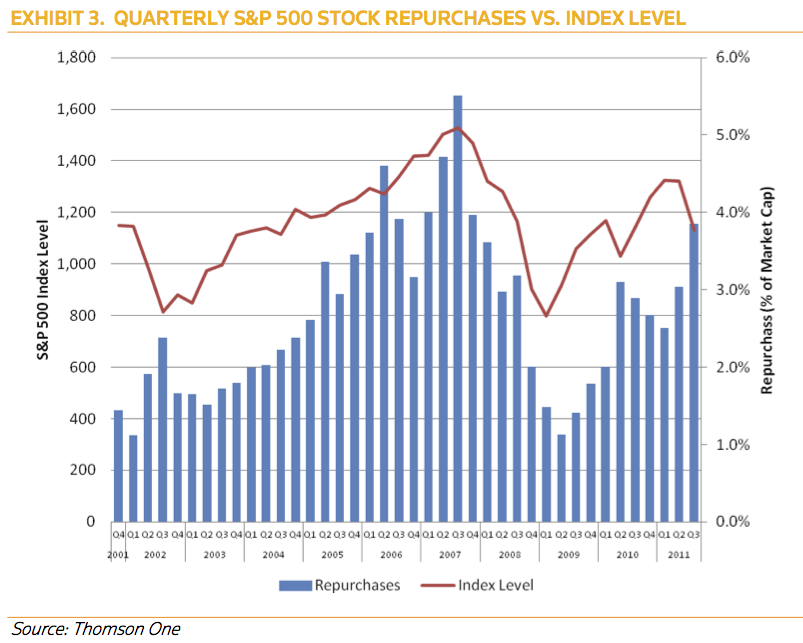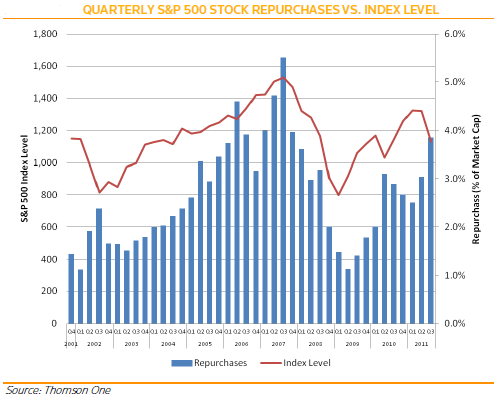A Breakdown Of Stock Buybacks
Post on: 16 Март, 2015 No Comment

There are a number of ways in which a company can return wealth to its shareholders. Although stock price appreciation and dividends are the two most common ways of doing this, there are other useful, and often overlooked, ways for companies to share their wealth with investors. In this article, we will look at one of those overlooked methods: share buybacks. We’ll go through the mechanics of a share buyback and what it means for investors.
Typically, buybacks are carried out in one of two ways:
1. Tender Offer
If you ask a firm’s management, they’ll likely tell you that a buyback is the best use of capital at a particular time. After all, the goal of a firm’s management is to maximize return for shareholders and a buyback generally increases shareholder value. The prototypical line in a buyback press release is we don’t see any better investment than in ourselves. Although this can sometimes be the case, this statement is not always true.
Nevertheless, there are still sound motives that drive companies to repurchase shares. For example, management may feel the market has discounted its share price too steeply. A stock price can be pummeled by the market for many reasons like weaker-than-expected earnings results, an accounting scandal or just a poor overall economic climate. Thus, when a company spends millions of dollars buying up its own shares, it says management believes that the market has gone too far in discounting the shares — a positive sign.
Improving Financial Ratios
Another reason a company might pursue a buyback is solely to improve its financial ratios — metrics upon which the market seems to be heavily focused. This motivation is questionable. If reducing the number of shares is not done in an attempt to create more value for shareholders but rather make financial ratios look better, there is likely to be a problem with the management. However, if a company’s motive for initiating a buyback program is sound, the improvement of its financial ratios in the process may just be a byproduct of a good corporate decision. Let’s look at how this happens.
First of all, share buybacks reduce the number of shares outstanding. Once a company purchases its shares, it often cancels them or keeps them as treasury shares and reduces the number of shares outstanding, in the process.
Moreover, buybacks reduce the assets on the balance sheet (remember cash is an asset). As a result, return on assets (ROA) actually increases because assets are reduced; return on equity (ROE) increases because there is less outstanding equity. In general, the market views higher ROA and ROE as positives.
Suppose a company repurchases one million shares at $15 per share for a total cash outlay of $15 million. Below are the components of the ROA and earnings per share (EPS) calculations and how they change as a result of the buyback.
As you can see, the company’s cash hoard has been reduced from $20 million to $5 million. Because cash is an asset, this will lower the total assets of the company from $50 million to $35 million. This then leads to an increase in its ROA, even though earnings have not changed. Prior to the buyback, its ROA was 4% ($2 million/$50 million) but after the repurchase, ROA increases to 5.71% ($2 million/$35 million). A similar effect can be seen in the EPS number, which increases from 20 cents ($2 million/10 million shares) to 22 cents ($2 million/9 million shares).
The buyback also helps to improve the company’s price-earnings ratio (P/E). The P/E ratio is one of the most well-known and often-used measures of value. At the risk of oversimplification, when it comes to the P/E ratio, the market often thinks lower is better. Therefore, if we assume that the shares remain at $15, the P/E ratio before the buyback is 75 ($15/20 cents); after the buyback, the P/E decreases to 68 ($15/22 cents) due to the reduction in outstanding shares. In other words, fewer shares + same earnings = higher EPS!
Based on the P/E ratio as a measure of value, the company is now less expensive than it was prior to the repurchase despite the fact there was no change in earnings.

Dilution
Another reason that a company may move forward with a buyback is to reduce the dilution that is often caused by generous employee stock option plans (ESOP).
Bull markets and strong economies often create a very competitive labor market — companies have to compete to retain personnel and ESOPs comprise many compensation packages. Stock options have the opposite effect of share repurchases, as they increase the number of shares outstanding when the options are exercised. As was seen in the above example, a change in the number of outstanding shares can affect key financial measures such as EPS and P/E. In the case of dilution, it has the opposite effect of repurchase: it weakens the financial appearance of the company.
Continuing with the previous example, let’s assume, instead, that the shares in the company had increased by one million. In this case, its EPS would have fallen to 18 cents per share from 20 cents per share. After years of lucrative stock option programs, a company may feel the need to repurchase shares to avoid or eliminate excessive dilution.
Tax Benefit
In many ways, a buyback is similar to a dividend because the company is distributing money to shareholders. Traditionally, a major advantage that buybacks had over dividends was that they were taxed at the lower capital-gains tax rate. whereas dividends are taxed at ordinary income tax rates. However, with the Jobs and Growth Tax Relief Reconciliation Act of 2003. the tax rate on dividends is now equivalent to the rate on capital gains.
The Bottom Line














